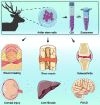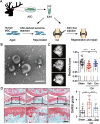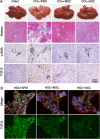The characteristics and medical applications of antler stem cells
- PMID: 37649124
- PMCID: PMC10468909
- DOI: 10.1186/s13287-023-03456-8
The characteristics and medical applications of antler stem cells
Abstract
Antlers are the only fully regenerable mammalian appendages whose annual renewal is initiated by antler stem cells (ASCs), defined as a specialized type of mesenchymal stem cells (MSCs) with embryonic stem cell properties. ASCs possess the same biological features as MSCs, including the capacity for self-renewal and multidirectional differentiation, immunomodulatory functions, and the maintenance of stem cell characteristics after multiple passages. Several preclinical studies have shown that ASCs exhibit promising potential in wound healing, bone repair, osteoarthritis, anti-tissue fibrosis, anti-aging, and hair regeneration. Medical applications based on ASCs and ASC-derived molecules provide a new source of stem cells and therapeutic modalities for regenerative medicine. This review begins with a brief description of antler regeneration and the role of ASCs. Then, the properties and advantages of ASCs are described. Finally, medical research advances regarding ASCs are summarized, and the prospects and challenges of ASCs are highlighted.
Keywords: Antler; Medical applications; Stem cells.
© 2023. BioMed Central Ltd., part of Springer Nature.
Conflict of interest statement
The authors declare that they have no competing interests.
Figures






Similar articles
-
New physiological insights into the phenomena of deer antler: A unique model for skeletal tissue regeneration.J Orthop Translat. 2020 Dec 24;27:57-66. doi: 10.1016/j.jot.2020.10.012. eCollection 2021 Mar. J Orthop Translat. 2020. PMID: 33437638 Free PMC article. Review.
-
Deer antler--a novel model for studying organ regeneration in mammals.Int J Biochem Cell Biol. 2014 Nov;56:111-22. doi: 10.1016/j.biocel.2014.07.007. Epub 2014 Jul 18. Int J Biochem Cell Biol. 2014. PMID: 25046387 Review.
-
Antler stem cells as a novel stem cell source for reducing liver fibrosis.Cell Tissue Res. 2020 Jan;379(1):195-206. doi: 10.1007/s00441-019-03081-z. Epub 2019 Aug 19. Cell Tissue Res. 2020. PMID: 31428875
-
Antler stem cells and their potential in wound healing and bone regeneration.World J Stem Cells. 2021 Aug 26;13(8):1049-1057. doi: 10.4252/wjsc.v13.i8.1049. World J Stem Cells. 2021. PMID: 34567424 Free PMC article. Review.
-
Single-cell transcriptome provides novel insights into antler stem cells, a cell type capable of mammalian organ regeneration.Funct Integr Genomics. 2019 Jul;19(4):555-564. doi: 10.1007/s10142-019-00659-2. Epub 2019 Jan 23. Funct Integr Genomics. 2019. PMID: 30673893
Cited by
-
Dual-network hydrogel loaded with antler stem cells conditioned medium and EGCG promotes diabetic wound healing through antibacterial, antioxidant, anti-inflammatory, and angiogenesis.Mater Today Bio. 2025 Feb 24;31:101612. doi: 10.1016/j.mtbio.2025.101612. eCollection 2025 Apr. Mater Today Bio. 2025. PMID: 40104648 Free PMC article.
-
A Novel Deer Antler-Inspired Bone Graft Triggers Rapid Bone Regeneration.Adv Mater. 2025 Feb;37(6):e2411571. doi: 10.1002/adma.202411571. Epub 2024 Dec 20. Adv Mater. 2025. PMID: 39707695 Free PMC article.
-
The Role of Tumor Stem Cells in Colorectal Cancer Drug Resistance.Cancer Control. 2024 Jan-Dec;31:10732748241274196. doi: 10.1177/10732748241274196. Cancer Control. 2024. PMID: 39215442 Free PMC article. Review.
-
Adipose-Derived Stem Cells: Angiogenetic Potential and Utility in Tissue Engineering.Int J Mol Sci. 2024 Feb 16;25(4):2356. doi: 10.3390/ijms25042356. Int J Mol Sci. 2024. PMID: 38397032 Free PMC article. Review.
-
An effective approach to cartilage regeneration using antler stem cell-conditioned medium.Sci Rep. 2025 Jul 31;15(1):27971. doi: 10.1038/s41598-025-13841-3. Sci Rep. 2025. PMID: 40745014 Free PMC article.
References
-
- De Luca M, Aiuti A, Cossu G, Parmar M, Pellegrini G, Robey PG. Advances in stem cell research and therapeutic development. Nat Cell Biol. 2019;21(7):801–811. - PubMed
-
- Bacakova L, Zarubova J, Travnickova M, Musilkova J, Pajorova J, Slepicka P, et al. Stem cells: their source, potency and use in regenerative therapies with focus on adipose-derived stem cells—a review. Biotechnol Adv. 2018;36(4):1111–1126. - PubMed
-
- Kuo YR, Wang CT, Cheng JT, Kao GS, Chiang YC, Wang CJ. Adipose-derived stem cells accelerate diabetic wound healing through the induction of autocrine and paracrine effects. Cell Transplant. 2016;25(1):71–81. - PubMed
Publication types
MeSH terms
LinkOut - more resources
Full Text Sources
Miscellaneous

